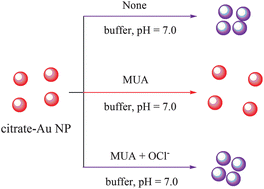Detecting bacteria using magnetic nanoparticles
Nowadays, the standard method for detecting bacteria in food samples is through the use of conventional cell culture and immunoassays using fluorescent and radioactive tags. While this method is very accurate, it does not allow real-time, on-site analysis. From Pohang University of Science and Technology, Korea, comes the work of Sangmin Jeon and coworkers who have developed a simple, and rapid method for the detection of pathogenic bacteria in foods using magnetic nanoparticles and TiO2 nanocrystals. To read how they have accomplished this, click on the title below.
A facile and sensitive detection of pathogenic bacteria using magnetic nanoparticles and optical nanocrystal probes
Jinmyoung Joo, Changyong Yim, Donghoon Kwon, Jaejin Lee, Hwa Hui Shin, Hyung Joon Cha and Sangmin Jeon
Analyst, 2012, Advance Article
DOI: 10.1039/C2AN35369E
Colorimetric determination of hypochlorite
Xiurong Yang and colleagues from the Changchun Institute of Applied Chemistry, China, have made a colorimetric method using gold nanoparticles to detect hypochlorite (OCl–) in water. The assay can be performed in two easy steps and could possibly help with environmental monitoring of OCl−/HOCl in waters sanitized by chlorine or hypochlorite compounds. Click on the link below to read more about their research.
Colorimetric determination of hypochlorite with unmodified gold nanoparticles through the oxidation of a stabilizer thiol compound
Jia Zhang, Xiaolei Wang and Xiurong Yang
Analyst, 2012, Advance Article
DOI: 10.1039/C2AN35239G












